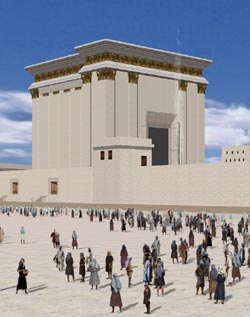 |
The Architecture
of the Temple Mount
Herod's Building Proclamation
The Talmud quotes Herod's temple as the most magnificent building in the world (The Babylonian Talmud, Bava Bathra 4a). However, when Herod first announced his plan to rebuild the Jewish temple on Mount Moriah (Jewish Antiquities, Book 15, Chaper 11, 382-387) his offer was not, to say the least, welcomed. Herod, son of Antipater the
Idumean, reigned over Judea in the years 40-4 BCE. Following his ascendance to the throne he not only ordered the assassination of his Hasmonean rivals, but also confiscated the possessions of the aristocracy of Jerusalem in order to pay his debts to Rome and to his army. These doings won him such a bad reputation among the Jewish people, that even his marriage to
Mariamne, a Hasmonean princess, did not improve his standing in their eyes.
|
  |
Thus, the Jews were very reluctant to allow Herod to replace the modest temple built some 470 years earlier by the Returnees to Zion from Babylonia. Not until King Herod laid out all the building materials required for the construction of the Temple Mount at the foot of the mountain and trained some 10,000 priests as builders, were the Jews agreeable to his grand offer (Jewish Antiquities, Book 15, Chapter 11, 388-390).
What was in it for Herod? The building operations undertaken by Herod and other Roman rulers served as a living monument of their accomplishments. The monumental architecture evidenced throughout the Roman Empire determined a ruler's status. The rebuilding of the temple compound by Herod also served an economic purpose. An expanded Temple Mount could accommodate multitudes of pilgrims contributing to the prosperity of the city. Herod's gain was, therefore, both political and economical.
The Walls of the Temple Mount
Of all of Herod's building enterprises, the Temple Mount was certainly the greatest. His plan was to erect a sacred enclosure with the temple in its center. This layout was similar to other such enclosures built throughout the Hellenistic world and the Roman Empire.
According to Jewish Law, the location of the temple (on Mount Moriah) and its measurements were predestined by God (see The Temple Mount in Traditional Thought; Mishna, Middoth). Hence, Herod could not relocate or expand the temple itself. The only improvements that could be introduced were the construction of a taller building and the use of richer materials. The major construction effort therefore focused on the erection of a vast platform to carry the temple. Enlarging the area of the Temple Mount to the north, the west and the south, Herod created a platform 144,000 sq m in area; the eastern wall of the Temple Mount remained as it was due to topographical constraints, i.e, the Kidron Valley. The
immense platform (480 m long, 280 m wide) was supported by four tremendous retaining walls. Varied cavities beneath the huge platform were roofed by arcades designated to relieve the pressure on the walls; some of these underground spaces were later used for various purposes, e.g.,
Solomon's Stables and the Cave Synagogue.
Methods of Construction
The Herodian construction of the retaining walls of the Temple Mount is easily identifiable: large, well-cut stones (the smaller ones weighing 2-4 tons) with Herodian dressed margins, set in horizontal courses, generally of uniform height (1-1.2 meters). At certain points along the base of the retaining walls, such as at the southwest corner of the Temple Mount, particularly sturdy construction called for the use of even larger stones (up to 50 tons). They were laid in alternating rows aligned east–west, above it north–south, and so on. The walls of the Temple Mount rest on bedrock, even where it is 7 meters deep! Neither mortar nor any other binding material was used between the stones, as stability was attained by the great weight of the stones and by the mildly graded recession of each constructive course by three to five centimeters.
The Herodian Building Blocks
The impressive retaining walls of the Temple Mount are characterized by huge building blocks, each finely chiseled with a flat projecting boss, surrounded by a frame. The frame is sunk some 2 cm below the face of the stone and its average width is 8 cm. A wide, toothed chisel, was used to smoothen the stone margins. Special care was taken in the chiseling of the vertical margins of adjacent stones.
In the eastern wall of the temple mount, about 32 m north of the southeastern corner, a vertical seam is recognizable: the courses of stones on each side of the 'seam' differ in size and workmanship. The northern section of the wall was probably constructed during the Hasmonean period while the southern part is typically Herodian. The Hasmonean section of the wall is built of huge margined stones of cruder workmanship than that of the Herodian building blocks.
The ‘seam’ of the eastern wall indicated that the origins of the margin-cutting style predates Herod's time, as witnessed in the Hellenistic architecture of Greece, Asia Minor and Alexandria, as well as in the Levant, e.g., the palace of the Sons of Tuvia at Iraq el-Amir in Jordan (near `Amman), dating from at least the third century BCE. Examples of pre-Herodian margin stone-cutting are also attested in Jerusalem: at the ‘Tower of David’ (the Paza’el Tower), in the "First city wall" and in the Hasmonean Tower unearthed in the Jewish quarter.
This stone-dressing method was so widely practiced in Herod's days that it is referred to as the ‘Herodian dressing'. ‘Herodian’ masonry is attested at the sites of Aloné Mamré (near Hebron), in the Cave of Machpelah (Hebron), in the Augusteum in Sebastia and possibly also in the Herodian platform at Caesarea. In Jerusalem, ‘Herodian' stones are preserved beneath the Damascus Gate.
Interestingly, this stone-dressing fashion serves as a decorative theme on Second Temple period ossuaries found in the Jerusalem area.
Stone Quarrying and Construction
The Temple and its enclosure walls were built of limestone. As the enclosure measured 300 x 480 m, and had high supportive walls on all sides, an enormous quantity of stone was needed for this magnificent edifice. Stone is an abundant commodity in the Jerusalem area, and indeed, the remains of numerous quarries can be found in the vicinity of the Old City. Two large quarries - one north of the Damascus Gate, the other known as Solomon's Quarries - are located north of the Old City, where thick layers of Meleke limestone are found.
Freeing the stones from the bedrock called for a series of operations: Wide grooves were chiseled with metal tools around the required stone block. The stone was then released from the quarry by driving metal wedges into the grooves. The initial dressing of the stone was probably conducted at the site. Many of the stones were of large size, most weighing between two to five tons. Immense effort was thus required, both to cut the stones and then to transport them. The largest stone found measures 12 m in length and 3 m high, and it weighed of course hundreds of tons! Transporting these huge stones to the building site was enabled by using a number of devices, including wheels and sleds (See Hoisting and Transporting Massive Stones).
Once deposited at the Temple site the stones were finely chiseled and then hauled into place using ramps, cranes and crow bars (See Hoisting and Transporting Massive Stones). The stones were laid in dry courses, mostly about 1 m high without the use of mortar. Each course was set 3-5 cm back from the course below. Final dressing and adjustments were conducted once the stones were set in place.

|
|

